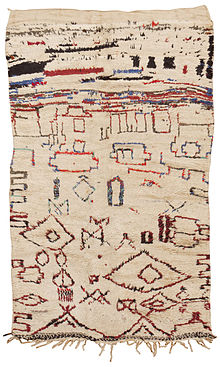Tibetan Rug History

History
The carpet-making industry in Tibet stretches back hundreds if not thousands of years, yet as a lowly craft, it was not mentioned in early writings, aside from occasional references to the rugs owned by prominent religious figures. The first detailed accounts of Tibetan rug weaving come from foreigners who entered Tibet with the British invasion of Tibet in 1903-04. Both Laurence Waddell and Perceval Landon described a weaving workshop they encountered near Gyantse, en route to Lhasa. Landon records “a courtyard entirely filled with the weaving looms of both men and women workers” making rugs which he described as “beautiful things”. The workshop was owned and run by one of the local aristocratic families, which was the norm in premodern Tibet. Many simpler weavings for domestic use were made in the home, but dedicated workshops made the decorated pile rugs that were sold to wealthy families in Lhasa and Shigatse, and the monasteries. The monastic institutions housed thousands of monks, who sat on long, low platforms during religious ceremonies, that were nearly always covered in hand-woven carpets for comfort. Wealthier monasteries replaced these carpets regularly, providing income, or taking gifts in lieu of taxation, from hundreds or thousands of weavers.
From its heyday in the 19th and early 20th century, the Tibetan carpet industry fell into serious decline in the second half of the 20th. Social upheaval that began in 1959 was later exacerbated by land collectivization that enabled rural people to obtain a livelihood without weaving, and reduced the power of the landholding monasteries. Many of the aristocratic families who formerly organized the weaving fled to India and Nepal during this period, along with their money and management expertise.
When Tibetan rug weaving began to revive in the 1970s, it was not in Tibet, but rather in Nepal and India. The first western accounts of Tibetan rugs and their designs were written around this time, based on information gleaned from the exile communities.] Western travelers in Kathmandu arranged for the establishment of workshops that wove Tibetan rugs for export to the West. Weaving in the Nepal and India carpet workshops was eventually dominated by local non-Tibetan workers, who replaced the original Tibetan émigré weavers. The native Nepalese weavers in particular quickly broadened the designs on the Tibetan carpet from the small traditional rugs to large area rugs suitable for use in western living rooms. This began a carpet industry that is important to the Nepalese economy even to this day, even though its reputation was eventually tarnished by child labor scandals during the 1990s.
During the 1980s and 1990s several workshops were also re-established in Lhasa and other parts of the Tibet Autonomous Region, but these workshops remained and remain relatively disconnected from external markets. Today, most carpets woven in Lhasa factories are destined for the tourist market or for use as gifts to visiting Chinese delegations and government departments. Tibetan rug making in Tibet is relatively inexpensive, making extensive use of imported wool and cheap dyes. Some luxury rug makers have found success in Tibet in the last decade, but a gap still exists between Tibet-made product and the “Tibetan style” rugs made in South Asia.


